
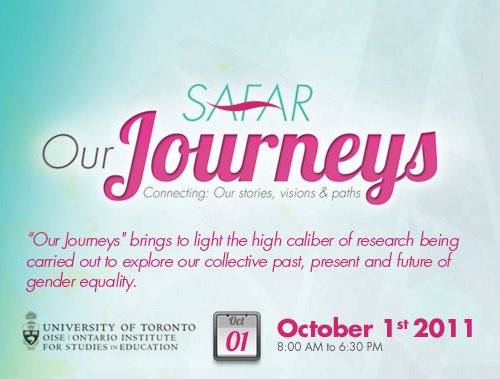 This post is a bit late, but every bit still important. Last week, the first “Sikh Feminist conference” – SAFAR – was held at the University of Toronto. The conference brought together academics, activists, and community members to reflect on the meanings and experiences of gender in a Sikh context. Opening with a keynote address by Nikky Guninder Kaur Singh, esteemed Professor at Colby College, the conference featured over 30 presentations. From the Param Marg Granth to questions of translation; from the Rahit Maryada to questions of film; from a historic opening for queer identities to questions on sex-selective abortion; from a discussion of women’s perceptions of body hair to even the questioning of questions, the conference can only be described as timely, pressing, and historic.
This post is a bit late, but every bit still important. Last week, the first “Sikh Feminist conference” – SAFAR – was held at the University of Toronto. The conference brought together academics, activists, and community members to reflect on the meanings and experiences of gender in a Sikh context. Opening with a keynote address by Nikky Guninder Kaur Singh, esteemed Professor at Colby College, the conference featured over 30 presentations. From the Param Marg Granth to questions of translation; from the Rahit Maryada to questions of film; from a historic opening for queer identities to questions on sex-selective abortion; from a discussion of women’s perceptions of body hair to even the questioning of questions, the conference can only be described as timely, pressing, and historic.
Some left in awe; some left troubled; some left challenged; some left with catharsis. All left inspired. To continue the momentum from the conference, the hosts of the conference, the Sikh Feminist Research Institute, is planning to convene a peer-reviewed online journal to publish quality articles related to gender.
Pictures from the conference can do far more justice than any thing I will write here. If you attended, share your thoughts and reflections. If you didn’t attend, you missed out!
We, here, at The Langar Hall will keep you informed about future developments.
By now I imagine most of you have heard about Occupy Wall Street in New York City and the growing “Occupy”  movement all over the country. Inspired by the mass uprisings of the Arab Spring, the movement is uniting under the banner, “We are the 99%”, in its protest of unprecedented economic inequality and Wall Street and corporate power and influence in the United States.
movement all over the country. Inspired by the mass uprisings of the Arab Spring, the movement is uniting under the banner, “We are the 99%”, in its protest of unprecedented economic inequality and Wall Street and corporate power and influence in the United States.
The official declaration of #OccupyWallStreet, released last week (as a working document), states:
As one people, united, we acknowledge the reality: that the future of the human race requires the cooperation of its members; that our system must protect our rights, and upon corruption of that system, it is up to the individuals to protect their own rights, and those of their neighbors; that a democratic government derives its just power from the people, but corporations do not seek consent to extract wealth from the people and the Earth; and that no true democracy is attainable when the process is determined by economic power. We come to you at a time when corporations, which place profit over people, self-interest over justice, and oppression over equality, run our governments. We have peaceably assembled here, as is our right, to let these facts be known.
The mainstream media coverage of the protest, now in its 18th consecutive day, has largely downplayed its significance or remained silent all together. Some in the movement, thus, raised $12,000 on Kickstarter in 3 days (now over $40K) and published 50,000 copies of the “Occupied Wall Street Journal,” grassroots media at its best. This says a lot about what is going on at Liberty Square (what protesters call the park they are occupying). People, many with little background in activism, are taking matters into their own hands, and building a democratic movement against corporate tyranny.
I have been participating in the growing protests regularly for the last week, and generally feel inspired and hopeful about what is happening in downtown Manhattan, despite some frustrations, some of which Sepia Mutiny just blogged about today. My time at Liberty Square–sometimes spent attending the nightly General Assemblies (where decisions are made by consensus, not unlike the Sikh Sarbat Khalsa process), sometimes participating in marches, sometimes playing a musical instrument–leaves me thinking about how this movement relates to Sikhs and Sikhi.
While Breakaway/SpeedySinghs seems to be the talk of the town, earlier this week, a friend (pagh salute: download!) pointed this new movie to me. It seems it is still in production and is a labor of love for Sikh-Australian, Rupinder Singh. On the internet there are few details about the movie.
Here is their description:
Visionary film by Rupinder Singh creating an original epic docu-feature based on some prominent events in Sikh history. The film takes the audiences to a thrilling journey where they learn about the difficult time on the Sikh community and about how they still came out victorious in spite of being tested by the time.
Labeled as a “docu-drama” the breath-taking views and professional camera pans seem like a quality production. Although I have some reservations with the period costumes, despite claims on the website for a “special emphasis” [note the contemporary Nihang weaponry and costume and contrast with the historical reconstruction – though it has been alleged to be Afghan – at the London exhibit], I will definitely go out and watch it. In fact, I just made a contribution!
Make a contribution, “like” their facebook page, check out their website, or just watch their trailer.

UPDATED ON 9/22/11 at 11:00am (after the fold)
On Wednesday, September 21st at 7pm, the state of Georgia plans to end the life of Troy Davis. Davis’s only hope at this  point may be if prison staff refuse to carry out the execution, if they courageously stand up for what is right, rather than blindly follow orders. He has stated many times, “They can take my body but not my spirit, because I have given my spirit to God.”
point may be if prison staff refuse to carry out the execution, if they courageously stand up for what is right, rather than blindly follow orders. He has stated many times, “They can take my body but not my spirit, because I have given my spirit to God.”
No, Troy Davis is not a Sikh nor does he or his case have any direct connection to the Sikh community. But I am writing this tonight, after his final attempt for clemency denied by the state, to ask you to keep Troy Davis in your thoughts and prayers and to take action in whatever way you see fit. You can immediately sign this petition, you can call or email Judge Penny Freesemann at 912-652-7252/pfreesemann@chathamcounty.org and urge the halt of the execution, you can attend a local rally, you can include Troy in your ardas.
Why?
Because since Davis’s conviction for the murder of a police officer in 1989, seven of the nine witnesses that testified against him have recanted their testimonies.
Because no murder weapon was ever found, and no DNA evidence exists connecting Davis to the crime.
Because some witnesses say another man committed the crime, a witness who testified against Davis.
Because many witnesses have stated in sworn affidavits that they were pressured or coerced by police into testifying against Troy Davis.
Because Troy Davis is a 42-year-old man who should have many more years to live on this planet.
Because as Sikhs, it is our duty to stand up for what is right. The planned execution of Davis is a tragic symptom of a broken and inhumane criminal justice system (which I’ve discussed before here and here). This is a Sikh issue. Indeed, Harinder Singh of the Sikh Research institute states,
As a Sikh, I must fight for criminal justice reforms, as the founders of my faith set the precedent when confronting the Mughal dynasty in South Asia. Guru Nanak confronted Emperor Babar over mass incarcerations, and Guru Hargobind championed prisoner’s rights by challenging Emperor Jahangir; both Gurus, founders of Sikhi, were imprisoned for doing so.
What are we willing to do for Troy Davis and the Troy Davises of the world?
It’s a matter of life and death.
For Update – see bottom of post
Although far from my home (hopefully @blighty and @joo kay singh can share), is an intriguing exhibit celebrating our beloved Darbar Sahib (erroneously called the Golden Temple) at Amritsar.
Nearly 80 artefacts from the past 200 years have been collected for this exhibit on display in central London. Most of the items are said to be from private collections and this will be the first time they have been publicly displayed. The entire exhibit is being organized by the UK Punjab Heritage Association and there is indication that it may travel.
Until then, enjoy the art through this BBC Video on the exhibit (unfortunately the BBC does not allow you to embed, so you’ll have to follow the link).
In conjunction, it seems Sathnam Sanghera of A Boy With a Top Knot fame will be chairing a panel at the upcoming DSC South Asian Literature Festival (Oct 7-24) titled: The Golden Temple of Amritsar: Reflections of the Past on October 14. The panel will highlight the Muslim rababi tradition of kirtan from one of the descendants of Bhai Mardana – Bhai Ghulam Muhammad Chand. Unfortunately, it will also feature that most media-astute of the neo-Nihangs and pedlar of neo-Sanatan nonsense – Nidar Singh – who now claims himself to be the “Last Sikh Warrior” (I wonder if he could take on Tom Cruise, who we all know is the Last Samurai). Regardless, the event is free and definitely worth a visit.
Our UK readers, let us know your thoughts!
I have shared my views on Manpreet Badal and the PPP in the past. I still stand by my analysis, but as the election draws nearer, the youth of Punjab are making their voices heard.
Recently Manpreet Badal has been visiting the US this month and gaining more and more popularity among the non-voting NRPs (Non-Resident Punjabis), but if this show of support can be capitalized in Punjab is yet to be seen. His campaign has had a few major hiccups recently, with supporters such as Rajya Sabha member, Varinder Singh Bajwa, being re-wooed by Punjab’s greatest snake-oil seller, Parkash Badal. This loss comes soon after Manpreet had lost the support of his former “right-hand man”, Charanjeet Brar. It has been a long few weeks.
Still amongst a large number of Punjabi youth, they are still showing their support and hope, through creating videos on youtube to help galvanize the youth.
Here is one such example, a parody of rapper Wiz Khalif’a’s celebration of his native Pittsburgh – Black and Yellow. Here the artists – Sugar Cane Records and Jogi – ask who to vote for – Chitta (the color associated with the Congress Party) or Neela (the color associated with the Akali Dal). Both are thieves, the difference only the color.

The issue of sex-selective abortion is not new here in The Langar Hall. A number of our bloggers have commented on this complex issue in the past; and even early community initiatives have been supported as well.
Recently I saw the official trailer of a documentary – It’s A Girl – that promises to look at the issue in China and India.
In India, China and many other parts of the world today, girls are killed, aborted and abandoned simply because they are girls. The United Nations estimates as many as 200 million girls(1) are missing in the world today because of this so-called “gendercide”.
Shot on location in India and China, It’s a Girl! explores the issue. It asks why this is happening, and why so little is being done to save girls and women.
The film tells the stories of abandoned and trafficked girls, of women who suffer extreme dowry-related violence, of brave mothers fighting to save their daughters’ lives, and of other mothers who would kill for a son. Global experts and grassroots activists put the stories in context and advocate different paths towards change, while collectively lamenting the lack of any truly effective action against this injustice.
Currently in post-production, It’s a Girl! is scheduled for an early 2012 release.
I invite our readers to take a look at the trailer and share their comments, as will I.

I was listening to NPR a few nights ago while cooking dinner and was excited to hear about a group of Christian and Catholic clergy in Alabama taking action against a new anti-immigrant law in their state.
A few months ago, Alabama followed in Arizona’s footsteps in passing a bill that many are calling the most sweeping anti-immigrant law in the country, going even farther than Arizona’s highly controversial SB 1070.
Alabama’s new bill, H.B. 56, includes similar provisions to Arizona’s SB 1070, including one that authorizes local police to ask anyone they stop about their immigration status based on “reasonable suspicion,” amounting to the legalization of racial profiling.
[H.B. 56] bars illegal immigrants from enrolling in any public college after high school. It obliges public schools to determine the immigration status of all students, requiring parents of foreign-born students to report the immigration status of their children.
The bill…also makes it a crime to knowingly rent housing to an illegal immigrant. It bars businesses from taking tax deductions on wages paid to unauthorized immigrants. (link)
The law also makes it illegal to enter into a contract with, harbor, or transport undocumented immigrants.
Alabama’s Methodist, Episcopal, and Roman Catholic Churches have sued the state of Alabama over this law, saying it violates their religious freedom. Melissa Patrick of the United Methodist Church of Alabama states, “This new legislation goes against the tenets of our Christian faith — to welcome the stranger, to offer hospitality to anyone.”
 Guestblogged by Mewa Singh.
Guestblogged by Mewa Singh.
A young and vibrant community in the diaspora, it is incumbent upon us to remember our trailblazers. Hari Singh Everest was one such person. I remember reading his name during my undergraduate days. Stumbling across the ‘Sikh Review’, when I should have been completing other studies, it was the first time I had read a literate Sikh journal in English. Skimming the names of editors and contributors on the back, I noticed one from my very own California – Yuba City to be exact. Hari Singh Everest. I didn’t know him, but the unusual last name stuck in my head.
It would be years later when I finally met him. Some years ago the Jakara Movement decided to sponsor the efforts of all the collegitate Californian Sikh Students Associations (SSAs) in building a unity float. Since then, the float at the Yuba City Nagar Kirtan has become an annual affair.. The Everest Family graciously opened their home and it was on one such opportunity that I got to sit down with Hari Singh and speak to him. I mentioned that I had read his name on that Sikh Review issue years ago and he smiled. He talked about his experiences in the Sikh community and as being a sort of ambassador during those early years. It is a conversation I cherish.
His life in the United States stretches back to the 1950s (before the ‘Great Society’ immigration policy of LBJ) and his life in Yuba City goes back to 1961.
 If you were looking to attend a Sikh retreat a decade ago, you may have had a difficult time finding one. Thankfully, this is no longer the case. We are now fortunate enough to have a plethora of retreats and conferences to participate in. These retreats offer Sikhs an opportunity to cultivate our spirituality in hopes of moving us forward on our journey, whatever stage we may be at.
If you were looking to attend a Sikh retreat a decade ago, you may have had a difficult time finding one. Thankfully, this is no longer the case. We are now fortunate enough to have a plethora of retreats and conferences to participate in. These retreats offer Sikhs an opportunity to cultivate our spirituality in hopes of moving us forward on our journey, whatever stage we may be at.
For the past several Septembers, I’ve packed up my things and traveled to Santa Cruz to attend Saanjh. Each year, i come back feeling fulfilled and rejuvinated. This year’s Saanjh will be particularly special – the organizers will be offering Amrit Sanchaar for those individuals who are ready to make this commitment. A note from the organizers states:
Photo Credit: Gurumustuk Singh
We are proud to announce that there will be a ‘Khandey Baatey di Paul’/ ‘Amrit Sanchaar’ at Saanjh this year. Khande di Pahul or Amrit is the most spiritually significant event in a Sikh’s life. When one decides to partake in Amrit, she or he makes a commitment to walk the Sikh spiritual path. Amrit is the beginning of a journey, not the end–it’s akin to admission into a school to study a subject matter seriously, not graduation. For those of you who are looking to make the commitment, may we offer Saanjh as the venue for your commitment ceremony.
The retreat will bring together young Sikhs from across North America (and sometimes beyond!) to participate and engage in Sikhi. Whether or not we are ready to take Amrit – Saanjh offers us a unique opportunity to observe and learn about this very special ceremony. The retreat is a venue where we can learn about these significant and important aspects of Sikhi and feel supported as we embrace our individual journeys. The sessions are dynamic and promise to inspire participants. This year’s breakout sessions will include, “Guru and I”, “Poetry is Not a Luxury”, “Vaisakhi of 1699”, “2084: Looking Back, Looking Forward”, and “Gendered Violence and Spirited Sikh Resistance”.
Saanjh is open to all above 18 years of age and will be held this year from September 8th to 11th 2011. Please see the website for more information and register before prices increase! See you there Langarites!
Guest blogged by Gurchit Singh. Gurchit is a 16-year-old aspiring activist (in his own words) who submitted this piece (his first) to The Langar Hall. Raksha Bandan was last Saturday, August 13th.
Oh the joys of Raksha Bandan! The air is filled with love, family members are conversing and munching on a plethora of  sweets, hugs and kisses are being ecstatically extended to any and all family members the overemotional-mother can seem to get her loving arms around, and the overall mood in the home is one which many families can only dream of experiencing on a daily basis. Unfortunately, these loving moments only further promote a holiday which demotes women and opposes aspects of Sikhism itself.
sweets, hugs and kisses are being ecstatically extended to any and all family members the overemotional-mother can seem to get her loving arms around, and the overall mood in the home is one which many families can only dream of experiencing on a daily basis. Unfortunately, these loving moments only further promote a holiday which demotes women and opposes aspects of Sikhism itself.
While occupying myself with Facebook and sipping warm milk on the morning of Raksha Bandan, I was going through my daily routine of checking any notifications I may have received from the prior night. After reading many generic Raksha Bandan-related salutations, I finally came across one that actually defined what it was actually aimed at achieving: “Raksha Bandhan is a festival which celebrates the relationship between brothers and sisters. The ceremony involves the tying of a rakhi (sacred thread) by a sister on her brother’s wrist. This symbolizes the sister’s love and prayers for her brother’s well-being, and the brother’s lifelong vow to protect her.” While reading this definition, the two phrases that IMMEDIATELY jumped out at me were “sacred thread”, which conjured an instant connection to one of Guru Nanak Dev Ji’s earliest forms of rebellion against what he believed aimless and biased: the Janeu ( the full Sakhi can be referenced here), and “brother’s lifelong vow to protect her”, which called forth an image of a frail young woman constantly relying on her brother for protection from external occurrences.
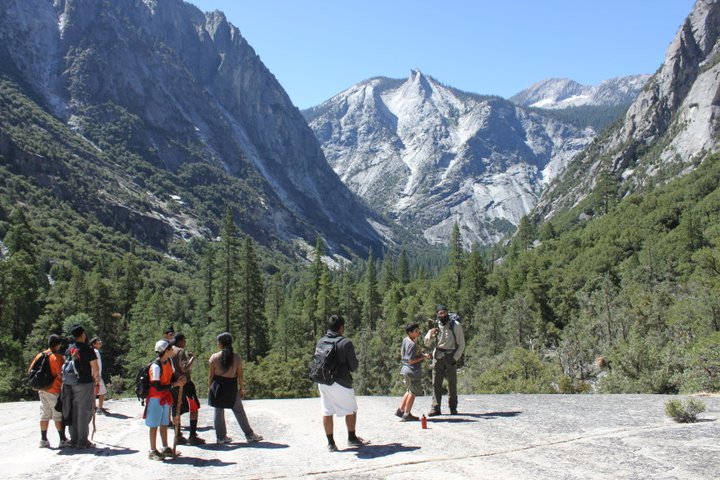 Guestblogged by Mewa Singh.
Guestblogged by Mewa Singh.
Here are some general musings and broader notes/reflections that were sparked by my participation in the camp:
On Parenting – One thing I found quite interesting was changes in parenting styles. I don’t remember having had many choices as a child, when my parents were going to put their foot down, and it seems my own parents confirm this. With the camp, I noticed we had so many parents expressed their desire for their sons to attend, only to begin avoiding our calls as the date approached and telling us our son doesn’t want to go. Many of the same parents often complained – our son doesn’t listen to us and just watches TV all day. I was left wondering, how do these children have the choice? A parent has the ability to parent and limit the child’s television viewing, if they so desire. A parent is not helpless to say our child doesn’t listen so we must accept the status quo. Many parents desire to be the ‘friend’ of their child, or be the ‘good guy/gal’ and never say ‘no.’ With so many of my friends young parents, I wonder how they will be setting boundaries.
On Consumerism – Now members of our community are part of the broader society and one would hardly expect larger sociological issues such as consumerism to not affect us. Still the degrees seem far more now than in my youth. I remember kids having and even getting beat up and their shoes stolen if they had the latest Jordans. With 13-year olds having iPhones, 16-year olds getting BMWs for their birthdays (Jodha had a reflection on this some time ago), and wardrobe prices that went far beyond our $15 jeans from Marshalls, I wonder what are we teaching our children? Ask parents to send their children to a Sikh workshop or even Punjabi/Khalsa school at their Gurdwara and parents will begin about fees being far too high. What do we actually value and what do we wish to teach our children to value?
Guest-blogged by Mewa Singh. Mewa Singh is a sevadar with the Jakara Movement.
Reviving and reinterpreting our historic terminology were part of the naming process of this unique camp.
With the Guru’s Grace, from August 1-10, I had the opportunity to be a sevadar for the Jakara Movement’s first annual Bhujangi Youth Academy. Unlike anything else in our community before, the academy specifically served the needs of at-risk young Punjabi Sikh males.
Yes, we disagree. Yes, most of you even fight amongst yourselves. Our voices and opinions are as diverse as the people in our community. So be it. This is how we learn from one another.
Sometimes you challenge us (the bloggers). Most of the time you challenge each other (the commenters). Do I wish the level of discussion with each other could be raised? At times, yes. Do I appreciate that you take the time to engage? ABSOLUTELY! Why? Because you care enough about the community, about Gurbani, about our collective future to engage.
Guest blogged by Naujawani Sardar
When the riots began in London last Saturday, we all thought they were a one-off incident and the world would be back to normal by Monday. Instead we awoke to find that more shops had been looted, buildings were still being set ablaze and that the rioters were now widening their search for new canvases to destruct. The thought was certainly there in the back of my mind, throughout my working day on Monday, but I think I purposely ignored it, hoping that it just would not happen: could a gurdwara be targeted?
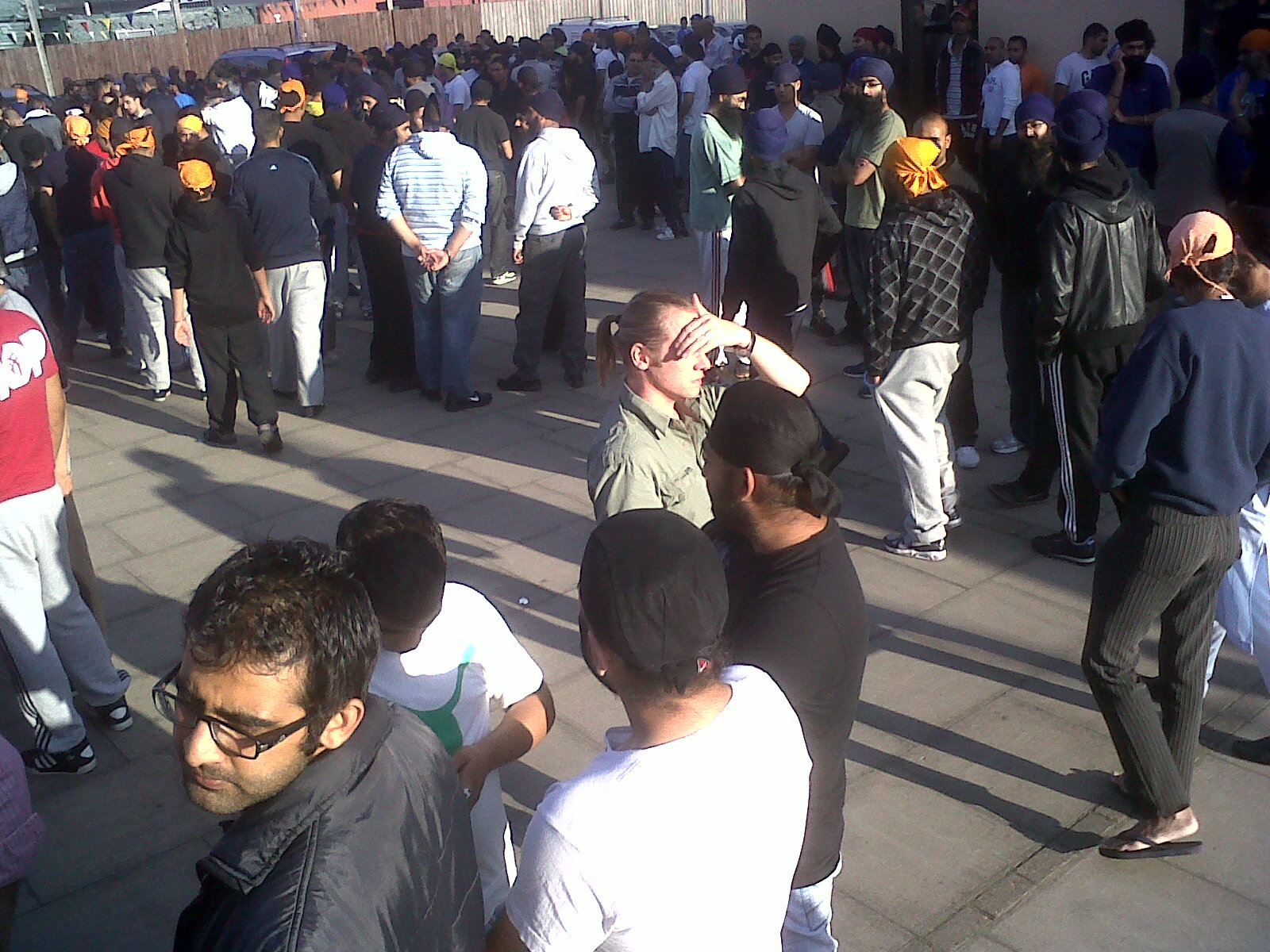 A small number of Sikhs however did not let the thought fall out of sight and continued to monitor the situation. Having realised that a problem may arise, albeit very late at night, they spent the best part of the night driving across London from one Gurdwara to the next to ensure that there was adequate security in place. Where there was not, one man stayed behind or where possible, awoke a local friend to come in. Thus was sewn the seed for a collaborative effort from a number of individuals to coordinate Sikhs that wanted to defend their Gurdware. Throughout Tuesday, Facebook, Twitter and SMS text messages were used to inform and mobilise people into preparing for the night(s) ahead. We at Naujawani also played a small role in coordinating these efforts and garnering support from individuals which personally gave me a greater insight into how things developed over the last 48 hours. It was clear to a few of us that if we were to have any success, people had to be appropriately distributed to different Gurdware. In west London, Southall is naturally the hub and meeting point, but throughout the rioting other Gurdware to the north and east of London were at a higher risk.
A small number of Sikhs however did not let the thought fall out of sight and continued to monitor the situation. Having realised that a problem may arise, albeit very late at night, they spent the best part of the night driving across London from one Gurdwara to the next to ensure that there was adequate security in place. Where there was not, one man stayed behind or where possible, awoke a local friend to come in. Thus was sewn the seed for a collaborative effort from a number of individuals to coordinate Sikhs that wanted to defend their Gurdware. Throughout Tuesday, Facebook, Twitter and SMS text messages were used to inform and mobilise people into preparing for the night(s) ahead. We at Naujawani also played a small role in coordinating these efforts and garnering support from individuals which personally gave me a greater insight into how things developed over the last 48 hours. It was clear to a few of us that if we were to have any success, people had to be appropriately distributed to different Gurdware. In west London, Southall is naturally the hub and meeting point, but throughout the rioting other Gurdware to the north and east of London were at a higher risk.
Guest blogged by Naujawani Sardar
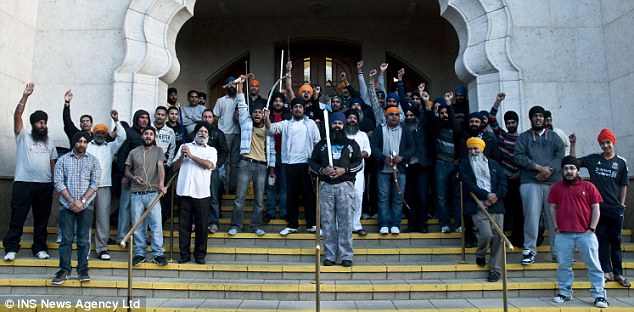 Riots have hit London and a few other cities in the UK over the last three nights causing mayhem, destroying property and leading to looting. Tonight, hundreds of Sikhs are gathering to defend the Gurdware in these cities should they fall under the eye of the looters. It is bringing together Sikhs of all backgrounds and affiliations; promising a glimmer of hope from an otherwise horrible situation.
Riots have hit London and a few other cities in the UK over the last three nights causing mayhem, destroying property and leading to looting. Tonight, hundreds of Sikhs are gathering to defend the Gurdware in these cities should they fall under the eye of the looters. It is bringing together Sikhs of all backgrounds and affiliations; promising a glimmer of hope from an otherwise horrible situation.
To find out more about this mobilisation of Sikhs, go to the Sikh Riot Awareness UK page.
The trigger has been widely recognised as the shooting of a 29 year old black man Mark Duggan in the Tottenham area of North London. 48 hours after his shooting, members of his family, friends and the wider community congregated outside Tottenham Police Station to protest at what they saw as the heavy-handed action of the London Metropolitan Police and the unhelpful communication from them about the matter in the following days. At this gathering of about some 300 protestors, a relatively minor confrontation between a teenager and the Police is said to have ignited running battles that ensued well into the night. A double decker bus was set alight and 49 fires were being dealt with by morning. But more importantly, as a sign of things to come, shops selling household goods, sportswear, toiletries and glasses were looted with CCTV images capturing hooded individuals taking away trollies laden with items.
Along with the start of the holy month of Ramadan, the last few weeks have seen an increase in momentum for laws that ban the wearing of the burqa and niqab in European 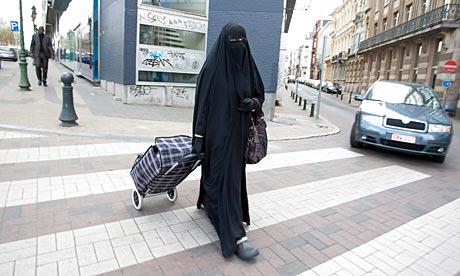 countries. We’ve talked about France before, where the implementation of its law banning Muslim face covering began this past spring. Now Belgium, which passed a similar measure last year, has begun implementing its ban on burqas as of July 23rd, and in Italy, new anti-burqa legislation was just passed by a parliamentary commission this week.
countries. We’ve talked about France before, where the implementation of its law banning Muslim face covering began this past spring. Now Belgium, which passed a similar measure last year, has begun implementing its ban on burqas as of July 23rd, and in Italy, new anti-burqa legislation was just passed by a parliamentary commission this week.
In both countries, like France, a miniscule number of women actually wear the burqa or niqab, begging the question of why an increasing number of European nations feel so threatened by it.
In Belgium, the lawmaker who proposed the bill, Daniel Bacquelaine, “said it was necessary to forbid the wearing of clothes that ‘totally mask and enclose’ the wearer. He described wearing the burqa as ‘not compatible with an open, liberal, tolerant society.’ Peter DeDecker of the Flemish separatist NVA saw the ban as a way of defending ‘our fundamental principles of the enlightenment.'”
Just as in France, what I would argue (and have previously argued) is an attack on religious freedom is being justified with the rhetoric of freedom and liberty (and public safety).
I love books – but I have a special, and perhaps curious, interest in books by and about Sikhs. Perhaps it’s the fascination to discover how similar or different our experiences are. I’m convinced i’m not alone in this. There has been an established interest in South Asian literature for quite some time, but now – with the growing number of authors covering the British Sikh or North American Sikh experience – there is piqued enthusiasm in diasporic “Sikh Literature”. I think it’s important to support this type of work – not simply because the author is Sikh or writes about Sikhs – but because until we have enough of this representation in literature, we need to encourage it’s growth. This also means that authors will be faced with higher expectations from their readers who want authentic stories, sophisticated writing and dymanic story telling – just as we’d expect from any other piece of literature.
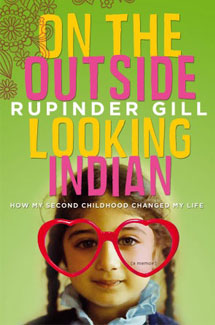 I recently read Rupinder Gill’s memoir, On the Outside Looking Indian. The premise and cover of the book attracted me, perhaps because it reminded me of Sathnam Sanghera’s, If You Don’t Know Me By Now – a book I highly recommend. Gill’s memoir, similar to Sanghera’s, deals with her personal experience growing up as the child of immigrants. Gill’s story is set in Canada and focuses on her year-long quest, at the age of about 30, to fulfill a list of her childhood dreams — learning to swim, going to Disney World, and living in New York etc – activities she didn’t participate in as a child. I found Gill’s descriptions of her childhood to be well-written, funny and often relatable.
I recently read Rupinder Gill’s memoir, On the Outside Looking Indian. The premise and cover of the book attracted me, perhaps because it reminded me of Sathnam Sanghera’s, If You Don’t Know Me By Now – a book I highly recommend. Gill’s memoir, similar to Sanghera’s, deals with her personal experience growing up as the child of immigrants. Gill’s story is set in Canada and focuses on her year-long quest, at the age of about 30, to fulfill a list of her childhood dreams — learning to swim, going to Disney World, and living in New York etc – activities she didn’t participate in as a child. I found Gill’s descriptions of her childhood to be well-written, funny and often relatable.
Without a doubt, many of us can relate to childhoods of inactivity – unless activity consisted of housework – then no, we really didn’t participate in many activities, especially compared to how busy and structured the lives of children are today. There are obvious exceptions to this, however, this is most likely a common experience for many. While Gill’s story is framed around a Panjabi Sikh household, it’s clear that her experiences could be those of many first-generation children whose parents have emigrated to new lands.
This Monday, Sikhs for Justice is organizing a rally at the United Nations Headquarters to call for UN intervention stop India’s planned execution of Professor Devenderpal Singh Bhullar. Professor Bhullar’s brother, Tejinder Singh Bhullar will be addressing the rally. In their appeal to Secretary General Ban Ki moon, Sikhs for Justice is calling upon the U.N. to intervene and free Professor Bhullar based on a UN General Assembly resolution adopted in 2008 known as Resolution 62/149 which called on all major states to abolish the death penalty. 62/149 is a nonbinding instrument to mark progress on the United Nation’s position that they death penalty undermines human dignity and acknowledges the serious claim that any failure of justice in the implementation of the death penalty is irreversible and irreplaceable.
 The death penalty too, runs contrary to Sikh historical positions on capital punishment. The Sarkar-e-Khalsa of Maharaja Ranjit Singh Ji, followed a no death penalty policy, as M. Gregor in his 1846 ‘History of the Sikhs’ writes. He notes that, ‘[Ranjit Singh] was the exception of Oriental monarchs, and never wantonly inflicted capital punishment and mutilation.’ Other authors describe, that ‘Humanity indeed, or rather a tenderness for life, was a trait in the character of Ranjit Singh. There is no instances of him having wantonly imbued his hands in blood.’ These sentiments that can be seen as consistent Sikh political philosophy captured by the Zafarnama and other documents. Specifically in the Zafarnama, Guru Gobind Singh Ji quotes the Persian poet Firdausi, writing, ‘How nicely the sweet tongued poet Firdausi has said, to act in haste is the work of the devil,’ referring to Aurungzeb’s executions of the youngest Sahibzadas Zorawar and Fateh Singh and Mata Gujri in Sirhind as the act of ‘Sheitan.’
The death penalty too, runs contrary to Sikh historical positions on capital punishment. The Sarkar-e-Khalsa of Maharaja Ranjit Singh Ji, followed a no death penalty policy, as M. Gregor in his 1846 ‘History of the Sikhs’ writes. He notes that, ‘[Ranjit Singh] was the exception of Oriental monarchs, and never wantonly inflicted capital punishment and mutilation.’ Other authors describe, that ‘Humanity indeed, or rather a tenderness for life, was a trait in the character of Ranjit Singh. There is no instances of him having wantonly imbued his hands in blood.’ These sentiments that can be seen as consistent Sikh political philosophy captured by the Zafarnama and other documents. Specifically in the Zafarnama, Guru Gobind Singh Ji quotes the Persian poet Firdausi, writing, ‘How nicely the sweet tongued poet Firdausi has said, to act in haste is the work of the devil,’ referring to Aurungzeb’s executions of the youngest Sahibzadas Zorawar and Fateh Singh and Mata Gujri in Sirhind as the act of ‘Sheitan.’

Amritsar, 1946
I’m going to continue on what appears to be our theme of the week here at TLH — Sikhs and sports. I’m not much of an athlete, though I had a good run of Little League baseball when I was a kid in North Carolina. I remember how goofy I felt wearing my team’s baseball cap over my patka and of course a helmet when I was up to bat. Looking back at the photographs, I looked pretty goofy too.
Fast forward a couple of decades, and I find myself in a related dilemma, though hardly an aesthetic one. This time of year in New York City, my favorite (and most efficient) way to get around is on my bike (the kind that requires pedaling). It’s good exercise, it gets me around Brooklyn and other parts of the city often as quick or quicker than public transit, and it leaves no carbon footprint.
As a dastaar-wearing Sikh, I grapple every day with my decision to ride my bike without a helmet — especially in a place like New York City. I’ve had many friends try to convince me to do otherwise, and I’ve tried many experiments of trying to make a helmet work. After talking to many a bike shop employees, my understanding at the moment is that bike helmets and turbans can’t really co-exist effectively. Even if I were to get an extra large helmet and put it over a small dastaar, it would not protect my skull sufficiently because it would sit too high up.


